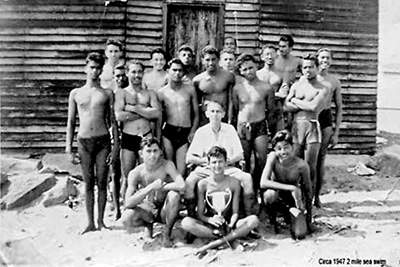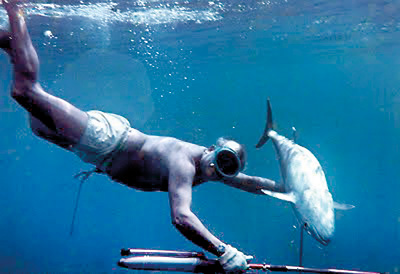Life then was one big splash
It was neither a shark nor a whale that fascinated six-year-old Rex De Silva. It was a tiny wew maluwa. Caught at the Basawakkulama, the young boy carried his prize home and hid it in his cupboard. Its pungent aroma was strangely refreshing – with it came a sense of freedom. The same smell would be carried around the village by the pingo-carriers as they flaunted their day’s catch. The little fish would be soon discovered and thrown away by his mother, but the fascination endured.

Rex De Silva on a dive: Words can’t describe the wonder
“The good old days were all about jumping into the sea and enjoying the freedom,” recalls Mr. De Silva who at 75, has spent his life exploring the depths of the ocean and studying the vistas of the skies, as a diver, marine biologist, underwater photographer, ornithologist, karate Grand Master and astronomer.
One of country’s most experienced divers, Mr. De Silva has a particular affinity for the sharks of Sri Lanka. His book that will be released this week – ‘The Sharks of Sri Lanka” – an illustrated guide on the many sharks that are found around the island is the culmination of long years of dedicated research. “Back in the 60’s, I would encounter sharks and quickly scribble a few notes down on anything I got my hands on,” says Mr. De Silva. These scribbles soon became a passion; the book documents 22 of the 61 shark species found around Sri Lanka.
He worked on the material for a great number of years but it was only when he found a suitable artist that the book was given the greenlight. “Jayantha Jinasena is a fabulous artist and he has done great justice to the subject,” he says. He also acknowledges Professor Sarath Kotagama and the Field Ornithology Group of Sri Lanka for taking on the publication. The semi-technical yet highly readable book will be launched on September 4, at the Colombo University’s Department of Zoology.
Interestingly he also raises certain questions about identification. “There are constraints in identifying some sharks as a Sri Lankan species; sharks which have been caught outside our territorial waters are occasionally unloaded in Sri Lankan harbours. This is the result of poaching in extra-territorial waters and occasionally of barter; hence, care is necessary in attempting to identify as Sri Lankan species.”

Rex De Silva: It was fascination at first sight
The most common oceanic shark found in our waters is the silky shark that is found in deep seas. Most of his encounters with a silky though have been at the Sunday market. “The blacktip reef sharks are the most seen. In fact one was spotted at Kinross just this morning,” he tells us enthusiastically, showing a quick snap one of his friends had taken from a camera phone.
Black-tip reef sharks belong to 99% of the species that are heavier than water, thus having to constantly swim in order to breathe. They use a technique called ram ventilation, while sharks such as the Bluntnose sixgill shark is lighter than water and can maintain depth without having to constantly swim.
The Gulper on the other hand, has a liver filled with oil which gives it added buoyancy, while the Sandtiger shark fills its intestines with air by surfacing every now and then. “As opposed to ram ventilation, certain sharks can carry out buccal respiration, where they open their mouths, take a gulp of water and let it past their gills,” he explains. Sharks would come to the shore by the evening and return to the mud-banks or the madey by dawn.
In those early days of diving in the 1950s, there were no diving schools or diving instructors. Rex De Silva banked entirely on instinct and Rick and Barbara Carrier’s book, “DIVE”. “I borrowed a Scuba unit, we called them ‘Aqualungs’ in those days, from Langston Pereira and set off to dive by myself,” he recalls. The Aqualung tied to a bicycle, head full of ideas, he began what would become a legendary career in diving. He still remembers Pereira’s words clear as crystal – if you’re coming up in a hurry, just breathe out!
“Diving is simply a fascination. What my eyes saw on the first dive is nothing that I can put to words, no picture can ever compare to it either,” recounts Mr. De Silva. They would dive out to any part of the sea they wished to – nobody questioned them. “Diving or anything for that matter back then came without restrictions,” says Mr. De Silva. “I used to be one of those crack-pots who dived in the monsoon,” he laughs.

Those were the days: Kinross Club in 1947 above, and right, his friend Rodney Jonklaas with a tuna
Only the daring learn the tricks of the trade, this veteran believes. ‘Reefcraft’ or ‘Reef-lore’ was coined by renowned diver Vicki Athukorala -Rex’s mentor- and includes niceties of the trade that one can only pick up through raw experience. “On the west coast in mid-April one can often hear a crackling or rattling ‘chiri chiri’ sound,” says Mr. De Silva. This, we learn, is made by Rake-gilled Mackerel often arriving in large shoals. The fish swim with their mouths and gills flared open, and their appearance is a clear sign that the south west monsoon is only a short time away. There would also be times when the sea is strangely calm, with only a wave here and a wave there. The fisherman call it the eeruwa, and it foresees a long low swell void of any fish. Reefcraft was just that… picking up the ocean’s signs and predicting an outcome.
The diving stories unfold and it leads us to one fine sunny day in 1970 when Mr. De Silva was diving in Trincomalee with a Swiss traveller, who wanted to dive more than 200 feet to break a personal record. “I suggested we dive on the Submarine Canyon,” says Mr. De Silva. That was a spur-of-the-moment decision. A rugger jersey and denim shorts was not the most suitable diving kit but it had to do, while his friend was properly clad in a wet jacket.
 “We decided to bounce dive (which meant returning to the surface without delay) from 250 feet,” he recalls. At 120 feet they were greeted by Emperor snappers, croakers and the precipitous sides of the canyon. At 170 feet the cold set in. At 200 feet Mr. De Silva was shivering so hard that he had to struggle to keep the regulator in his mouth. The European was relentless. 240 feet and a sharp pain jabbed at Mr. De Silva’s neck as he signalled that he could endure no more. Having fallen just 10 feet short of their target, they resurfaced safely. “It was only months later that it occurred to my friend Rodney Jonklaas that it was the deepest dive by a Sri Lankan.”
“We decided to bounce dive (which meant returning to the surface without delay) from 250 feet,” he recalls. At 120 feet they were greeted by Emperor snappers, croakers and the precipitous sides of the canyon. At 170 feet the cold set in. At 200 feet Mr. De Silva was shivering so hard that he had to struggle to keep the regulator in his mouth. The European was relentless. 240 feet and a sharp pain jabbed at Mr. De Silva’s neck as he signalled that he could endure no more. Having fallen just 10 feet short of their target, they resurfaced safely. “It was only months later that it occurred to my friend Rodney Jonklaas that it was the deepest dive by a Sri Lankan.”
Rex De Silva was certified by the Reefcombers of Ceylon, one of the world’s first diving clubs started by Rodney Jonklaas in 1946. He was later certified as a commercial diver in 1968 by the Colombo Port Commission. He also holds the Scientific Fellowship of the Zoological Society of London, is a Fellow of the Linnean Society of London and was elected to the Professional Membership of the Institute of Biology, Sri Lanka.
As much as the seas, the jungles too beckoned. He would venture out to the forests a good ten kilometres on foot with his Veddah friend Kaira, and in the misty morning with cat-like stealth, they would stalk the buffalo approaching smaller deer. The deer would soon meet an unfortunate end at their hands. “That was the way it was. I used to walk for miles, camp under a tree and eat what I shot,” says Mr. De Silva. But by the 1960s, he had laid down his shotgun and turned to conservation.
“It’s a completely different story today. Just last week I refused a friend’s offer to go leopard spotting in Yala. I can see enough and more traffic jams from Colombo, can’t I?” he shrugs. “I’ve already seen all the wonders of the Earth.. just that I didn’t have a fancy camera with me back then,” he says. (His wife, Punnya, would later gift him his beloved Nikonos underwater camera). “But we were the luckier generation,” he tells us with a wry smile.
“We were adventurous, we were daring and we learned as we dived,” he says lamenting that diving today has become far too organized, taking away the fun of it. “We took a lot of risks, but never have I been attacked by a shark.” He remembers a close encounter with a famously ferocious Tiger shark, only for it to glide away peacefully. “Occasional our catch would be stolen, but that’s all the harm they ever did. At least to me.”
Rex De Silva is one of the very few who were privileged to have seen the unspoilt waters of our island. With industrialised fishing depleting the fish stock, sharks too have become rare, but with adequate awareness and attention there is still a sliver of hope left. His book will hopefully raise more awareness of the treasures of the deep.


